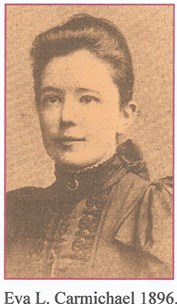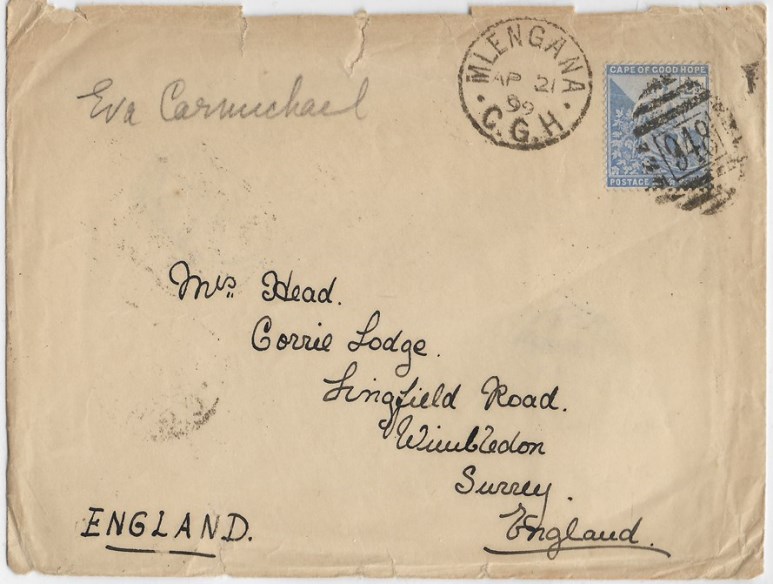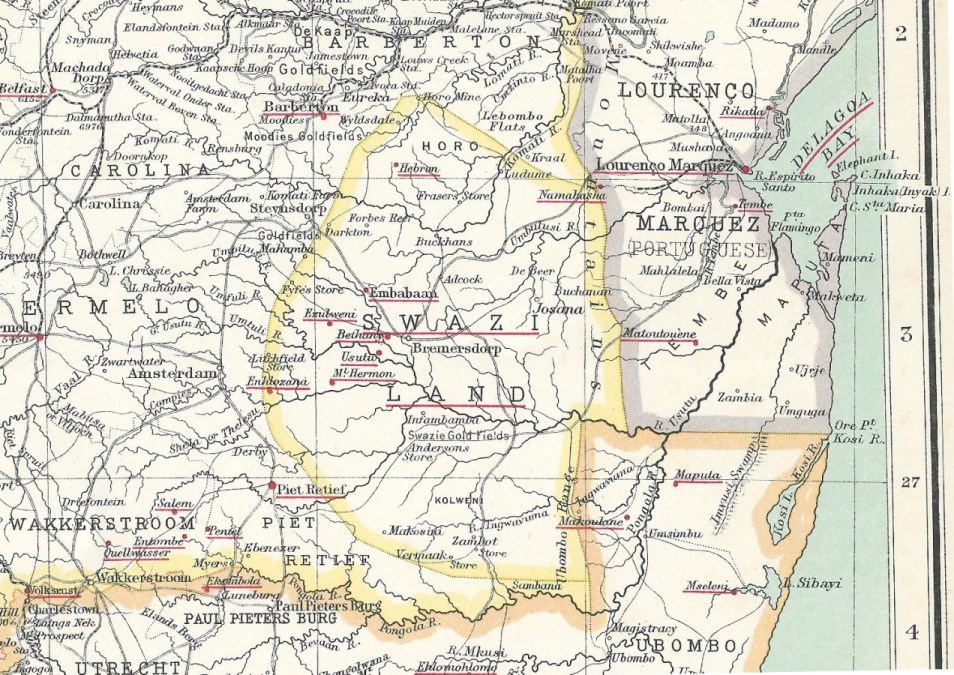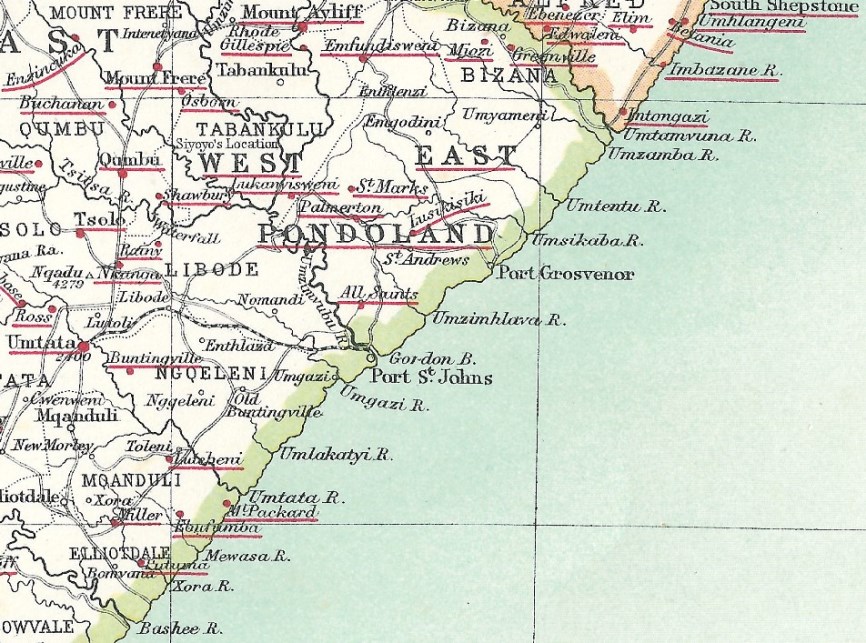This article should be read in conjunction with 'The "Mrs. Head" correspondence' 1
and 'The "Mrs. Head" correspondence, revisited – Daniel' 2.
Introduction
Joan Matthews and Andrew Higson introduced us to the 'Mrs. Head correspondence'. In the 1980s, Joan had seen dozens of covers at a stamp dealer’s shop in the West End of London, and realised their historical importance. In November 2009 Andrew questioned why Mrs Head had received so much mail from southern Africa.3 Later it was established that Mrs. Head was associated with the South Africa General Mission (SAGM).1 According to the Statistical Atlas of Christian Missions4 the original concept of the SAGM,5 an undenominational Christian union mission, was to fund and establish mission stations which could be offered to religious denominations to administer. However, in reality this was optimistic.
An article published in The Transvaal Philatelist in November 2019 recorded a missionary named Daniel in Swazieland during the 1890s and demonstrated that some missionaries called “workers” travelled a great deal.2 Therefore, they could have served at several mission stations and out-stations in the course of a few years, and often covered for other “workers” who were away, especially when on furlough.


This cover, addressed to Mrs. Head in Wimbledon, entered the post at Mlengana,6 Cape of Good Hope, on 21st April 1899 and arrived in Wimbledon on the, 13th May, where Caroline (Carrie) Head, annotated the name of the sender in pencil. As with all the known covers sent to Mrs Head, the envelope here has been roughly opened.
Eva L. Carmichael
Miss Carmichael had volunteered to work for the SAGM, although thus far no covers which entered the post in the South Africa Republic / Swaziland, Portuguese East Africa or Natal identifying her have been found. However, the cover illustrated here sent from the Cape validates her handwriting and it is hoped that this will help scholars of ZAR postal history to identify other covers from her.

Swazieland
Eva Carmichael sailed from the British Isles in the s.s. Pembroke Castle on "25th April 1896 and left Pessene, a lone Station, out of Delagoa Bay on 27th August with Miss Gabb, (who was returning to Hebron), and "our two native boys”. They were met by Mr. Wehmeyer, and once in Swaziland “Miss Harris & Miss Ellis rode over to welcome us."7 There were often problems reaching the mission stations in Swaziland and during 1896 the High Veld was impassable for a while to oxen as 'all grass being dried up'. A notice in The South African Pioneer, (SAP) of September 1896 reads as follows: 'Two horses and saddles are needed for two of our workers in Swazieland, Miss Ellis and Miss Eva Carmichael. A horse and saddle can be obtained for £15.' The “workers” in Swazieland, as reported in the SAP of October 1896,8 were Mr. & Mrs. Wehmeyer at Bethany, and Miss Harris, Miss Gabb and Miss Carmichael at Hebron. (Ellis was not cited.) However, "A severe attack of opthalmia9 quite laid aside for a time our Missionary Miss Eva Carmichael but we are glad to report her restoration and return to work."
The following is a precis of Eva L. Carmichael’s travels, demonstrating that further covers may be found.
Pondoland
The December 1897 edition of the SAP reported, (page 175) “Miss Carmichael has been transferred from Swazieland to Pondoland [Pondo-Bomuanr Group of Stations] and is now working with Mr. & Mrs. Cyril Green at Nkanga.”9a There were several reports of her here until after August 1899 when “Miss Carmichael … away at St. John’s, taking a well-earned rest.” The November 1899 edition of the SAP (page 178) reported by E. May Grimes and headed “Nkanga Pondoland”. “Miss Eva Carmichael and I have been away for a few days [September?] staying at Pondo Kraal at a distance from here in order to reach [the indigenous] ... [we] rode back to Nkanga assured that our labour was not in vain ...” Eva appears to have remained at Nkanga during the South African War until circa October 1902, when “Miss Winter will take Miss Eva Carmichael’s place, at Nkanga as she is returning to England on furlough”. She arrived in England safely and was a speaker at the Keswick Convention (Pavilion Hall, Cumbria, England) during [July?] 1903. Before March 1904, “Miss Carmichael is now safely back at Nkanga in Western Pondoland, and writes to say that she is very glad to be at work again amongst the Pondos.” There are photographs of her at Nkanga, on horse-back and standing outside her hut during 1903 and 1904. Before November 1904 she was in Lukanyisweni and wrote about her stay.10 In March 1906 she was staying at Lutubeni and from at least August 1908 at Ebufumba where she probably stayed until she returned to England in late 1911. The January report of the SAP for 1912 noted: “Eva Carmichael at Nkanga while Cyril Green and his wife were on furlough.” Before April 1912 she was back in England and was a speaker at a meeting at the “The Throne Room” on 24th April 1912. However, her situation must have changed, for in the SAP for August - September 1916 records “Regret the resignations, for various reasons, of Mr. & Mrs. Raney and Miss Carmichael.”

are underlined with red”. The marked mission stations in the latter are: Ebufumba, Nkanga, Lukanyisweni and Lutubeni.
Conclusion
The faith of these young women, who gave up their youth for this type of work, is extraordinary; particularly as they appeared never to be disappointed, and always found God in everything. There was often a touch of fun in their reports; for in May 1897 the SAP, page 57, reported: “The Church at N’kanga Pondoland. The congregation is dispersing after a weekday service for special prayer for rain. The answer to the prayer was so speedy that none of the congregation arrived home dry.”
References and Notes
1 Woolgar, J., (2010), The "Mrs. Head" correspondence, The Transvaal Philatelist, Vol. 45, No.3 (176), November 2010, pp.83-94.
2 Woolgar, J., and Stone, A., (2019), The "Mrs. Head" correspondence, revisited - Daniel, The Transvaal Philatelist, Vol.54, No.3 (204) November 2019, p.85.
3 Higson, A., (2009), The "Mrs. Head" Correspondence, The Transvaal Philatelist, Vol.44, No.4 (172), November 2009, p.93.
4 Statistical atlas of Christian missions, containing a directory of missionary societies, a classified summary of statistics, an index of mission stations, and a series of maps , (1910). World Missionary Conference 1910.
5 The South Africa General Mission evolved from The Cape General Mission during September 1894.
6 The cover was illustrated by Putzel who states: “1899 Proving cover BONC 948 = Mlengana. A confirmation … that this is correct. (M. Hamilton)", Putzel, R.F., (1997), The Postmarks of South Africa and Former States & Colonies, Vol.6 (Ma-Mo), Meyerspark, South Africa, pp.274, 275.
7 Eva L. Carmichael, ‘The journey to Hebron, Swaziland’, The South African Pioneer, January (1897), Vol.x, No.1, p.186.
8 Swazieland arrival dates of “workers”, sometimes referred to as “executive”, was recorded in The South African Pioneer as: 1889 Mr. & Mrs John & Annie Elizabeth Bailley and Mr. Coates. 1890 Mrs. Coates. 1893 Miss Harris, Miss Gabb, Mr. & Mrs. Wehmeyer. 1894 Alphaus [Hope], Miss Ellis.1896 Miss Eva Carmichael.
9 Inflammation of the eye, especially conjunctivitis.
9a Nkanga was recorded as new mission station from June 1895.
10 The South African Pioneer, November 1904, pp.180-181.
11 ‘Plate 6 Eastern South Africa.’ World Atlas of Christian Missions. Containing a directory of Missionary Societies, a classified summary of statistics ... and maps showing the location of Mission stations throughout the World (1911). [Maps by John Bartholomew & Co. Ltd.]